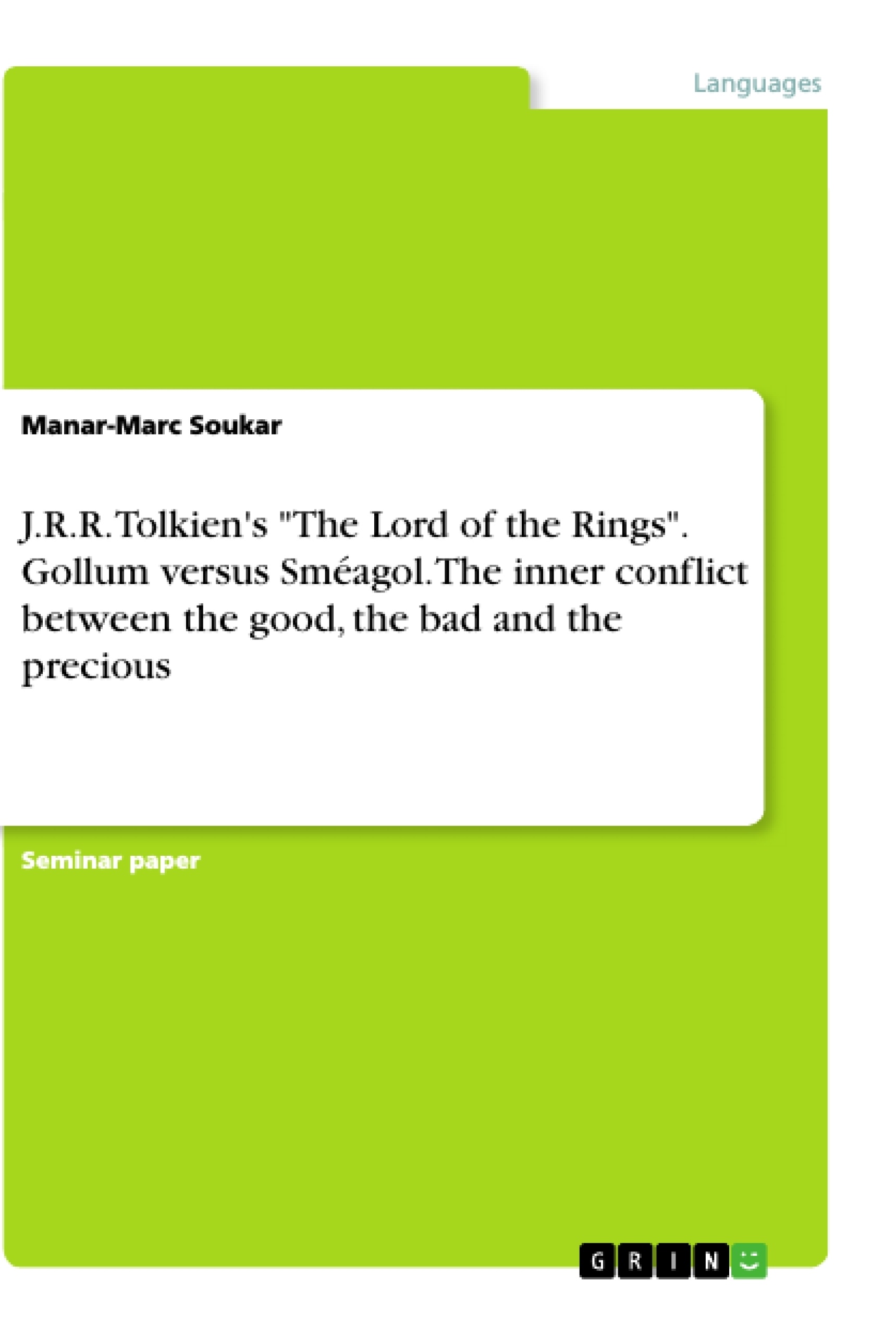This research paper will analyze the transformation of Sméagol to Gollum and his personality throughout the series, his rehabilitation and taming but also the spirit of good and evil. There will also be a pointing out on his style of speech and his conversations with himself throughout the tale.
To sum it up, the main goal of the illustration by Gollum, is to highlight the morality and philosophical significance of The Lord of the Rings, but moreover the inner conflict between this creature of Gollum and his own fight against his desire for the ring.
Table of Contents
- Introduction
- The Transformation of Gollum
- The Transformation from Sméagol to Gollum
- The Taming of Sméagol
- Style of Speech and Motives of Gollum and Sméagol
- The Inner conflict between the good and bad
- The heavily addiction to the ring and its powers
- Moral and philosophical perspective of Gollum
- Conclusion
Objectives and Key Themes
This research paper analyzes the character of Gollum in J.R.R. Tolkien's The Lord of the Rings, focusing on the internal conflict between his good (Sméagol) and evil (Gollum) sides, his addiction to the One Ring, and the moral and philosophical implications of his story. The paper explores Gollum's transformation, his relationship with the ring, and the use of his character to illustrate broader themes within Tolkien's work.
- Gollum's transformation from Sméagol
- The internal conflict between good and evil within Gollum
- Gollum's addiction to the One Ring and its consequences
- The moral and philosophical implications of Gollum's character
- Gollum's style of speech and its reflection of his inner turmoil
Chapter Summaries
Introduction: This introduction establishes the context of J.R.R. Tolkien's The Lord of the Rings, its cultural impact, and the paper's focus on Gollum's character. It highlights Gollum's duality (Sméagol/Gollum) and the exploration of good versus evil within his personality. The introduction connects Gollum's story to broader philosophical questions about morality and the human condition, framing the analysis within the context of popular culture's engagement with philosophical themes. The significance of the One Ring and Gollum's obsessive pursuit of it are also introduced as central to the analysis.
The Transformation of Gollum: This chapter delves into Gollum's transformation from the hobbit Sméagol into the creature Gollum. It examines the impact of the One Ring on Sméagol's personality and physical appearance, detailing the gradual shift into a being consumed by greed and malice. The chapter explores the lingering remnants of Sméagol's former self and the internal conflict between the two personalities. The analysis emphasizes how this transformation serves as a cautionary tale about the corrupting influence of power and the potential for darkness within even seemingly innocent individuals. Examples of Gollum's speech and behavior are examined to demonstrate this dramatic shift.
The Inner conflict between the good and bad: This chapter explores the internal conflict within Gollum, between the remnants of his former self, Sméagol, and his corrupted persona, Gollum. The analysis examines Gollum's addiction to the One Ring and its devastating impact on his morality and behavior. This section dives into the moral and philosophical implications of Gollum's story, examining the complex interplay of good and evil within a single character. It explores how Tolkien uses Gollum as a vehicle to explore larger philosophical questions about free will, redemption, and the nature of evil itself.
Keywords
J.R.R. Tolkien, The Lord of the Rings, Gollum, Sméagol, One Ring, good vs. evil, internal conflict, addiction, morality, philosophy, transformation, popular culture.
Frequently Asked Questions: A Comprehensive Language Preview of Gollum in *The Lord of the Rings*
What is the purpose of this document?
This document provides a comprehensive preview of a research paper analyzing the character of Gollum in J.R.R. Tolkien's The Lord of the Rings. It includes the table of contents, objectives and key themes, chapter summaries, and keywords.
What are the key themes explored in the research paper?
The paper focuses on Gollum's internal conflict between his good (Sméagol) and evil (Gollum) sides, his addiction to the One Ring, and the moral and philosophical implications of his story. It explores Gollum's transformation, his relationship with the ring, and how his character illustrates broader themes within Tolkien's work.
What topics are covered in each chapter?
Introduction: Sets the context of The Lord of the Rings, highlighting Gollum's duality and the exploration of good versus evil. It connects Gollum's story to broader philosophical questions. The Transformation of Gollum: Examines Gollum's transformation from Sméagol, detailing the impact of the One Ring and the internal conflict between the two personalities. The Inner Conflict Between Good and Bad: Explores the internal conflict within Gollum, his addiction to the One Ring, and the moral and philosophical implications of his story.
What is the significance of Gollum's transformation?
Gollum's transformation serves as a cautionary tale about the corrupting influence of power and the potential for darkness within seemingly innocent individuals. The analysis uses Gollum's speech and behavior to illustrate this dramatic shift.
What are the moral and philosophical implications of Gollum's character?
Gollum's story allows for an examination of complex issues such as free will, redemption, and the nature of evil. The paper explores how Tolkien uses Gollum to explore larger philosophical questions.
What keywords are associated with this research paper?
J.R.R. Tolkien, The Lord of the Rings, Gollum, Sméagol, One Ring, good vs. evil, internal conflict, addiction, morality, philosophy, transformation, popular culture.
What is the overall goal of the research?
The research paper aims to analyze Gollum's character in depth, focusing on his internal struggles, his relationship with the One Ring, and the broader philosophical and moral implications of his story within the context of Tolkien's work and popular culture.
- Quote paper
- Manar-Marc Soukar (Author), 2018, J.R.R. Tolkien's "The Lord of the Rings". Gollum versus Sméagol. The inner conflict between the good, the bad and the precious, Munich, GRIN Verlag, https://www.grin.com/document/457551




